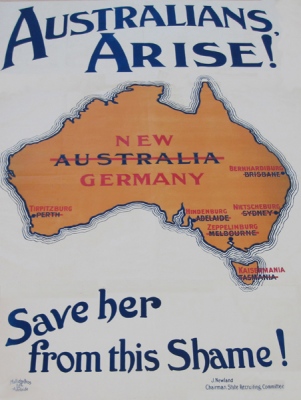THE GREAT WAR AND THE GERMAN COMMUNITIES
Germany was formed in 1871 when Bismarck united the German states. By 1914 it was a powerful country with a strong army but envious of Britain’s Navy and the empires of Britain and France. Although Britain had a large empire it feared the growing power of Germany and did not want Germany to get new colonies. France had lost some rich land to Germany in 1871. Some of the French wanted revenge, others feared their strong neighbour.
Russia too was concerned about the new strong Germany and wanted to control the Balkans to ensure its ships could reach the Mediterranean Sea. The Balkans – including Serbia, Bulgaria, Rumania, Albania and Greece – was considered the powder keg of Europe and the big European powers wanted control of it.
Austria and Hungary federated in 1867 to create a large empire, but many Hungarian people wanted to be free of Austrian control. Austria also wanted to control the Balkans and feared Russia’s power there. Serbia hated Austria because of their control of Hungary and tried to stir up trouble against it. Turkey, which controlled an old and crumbling empire, feared both Russian and Austrian power in the Balkans. It was out of this tense and paranoid situation that World War I exploded.
In 1914, Franz Ferdinand, a member of the Austrian Royal family, was assassinated in Serbia. As a result, Austria declared war on Serbia. Most of Europe had divided itself into alliances to protect each other if war broke out. Russia was an ally of Serbia and Germany of Austria – so when war broke out, Germany and Russia were drawn into it. France and England were allies of Russia (Triple Entente Alliance) and Italy and Turkey allies of Germany (Triple Alliance). All of these countries were pulled into the fight and Europe was at war.
When England went to war against Germany, Australia, still tied to Britain’s defence policies, was willingly drawn into the conflict providing troops and resources. In fact when war broke out, so many men volunteered that the Army could not provide enough weapons or uniforms. Those who didn’t enlist worked in factories and farms. Wheat farmers planted large crops because they thought England would need extra supplies of food. Graziers sold wool to the Commonwealth Government so that uniforms could be made. Families stuck pins into maps to show where the fighting was and who was winning. The Australian Government increased taxes to pay for the war. In October 1914, a new law, the War Precautions Act, gave the Government greater control over people’s lives.
Over 30,000 Germans lived in Australia in 1914. In 1915, Germans and Austrians who were old enough to join the army were put into internment camps. In New South Wales the three main internment camps were at Trial Bay Gaol, Berrima Gaol and Holsworthy. Women and children were interned at Molonglo. Others were carefully watched by the police and neighbours. Germans lost their jobs or had their business destroyed. Some voluntarily went into camps so their wives and children could survive on a government allowance. Some changed their names, some went into hiding and some were beaten up by militant mobs.
In other changes that affected Germans living in Australia their:
Schools and churches were closed
Music was banned
Food was renamed
Place names were changed to British ones – Blumberg became Birdwood, German Creek became Empire Bay and Germanton became Holbrook.
Traders, businessmen, sailors and tea planters in Southeast Asia were arrested and transported to Australia to be interned.
Anti German sentiments intensified in Australia after the Battle of the Ypres, Passchendaele and Pozieres saw appalling Australian casualties in France. Nationalism was rising as the main reaction to the war on the home front. Nationalistic propaganda posters and newsreels were created demonising and alienating the German community to bolster recruitment to replaces the losses on the Western Front. Nationalistic and anti- German propaganda was rampant in the Billy Hughes’ push for conscription.
Many sons and grandsons of German migrants joined the Australian Imperial Force and went to fight for Australia on the Western Front. Many, such as Tumbarumba’s George and Herbert Heinecke died in France. George and Henry’s father George senior, despite having lost two sons in the war, was constantly harassed because of his family’s German heritage. In a letter to the Tumbarumba Times in August 1918 he wrote:
I already have 17 (relatives at the front), including two sons who were killed, and one sister’s son also killed, and another sister’s son a prisoner of war in Germany; my wife’s brother’s three sons, two dead and one wounded.
Before war’s end memorials began to bloom across the Australian landscape. More than half of the Australian’s eligible white male population had enlisted and they were memorialised across the country by obelisks, stone soldiers and memorial avenues. However at Coonamble on Queensland’s Darling Downs, Rose Martyn, an Aboriginal mother of Charles who was killed at Ypres stood back from the crowd united in their mourning. She was alone and in tears, comforted by no-one. Between 400 – 500 Aboriginal men joined the Australian Imperial Force and most of these men fought overseas.
In 1917, when German submarines began to attack American cargo and passenger ships, the United States entered the war, committing over one million soldiers to the war in Europe. A socialist revolution in Russia deposed the old government, and led to a pull-out of Russian troops and a treaty with Germany. Germany’s allies, Austria – Hungary and Turkey, were severely weakened by the war and had to withdraw. Without support, and in the face of a fresh army from the United States, Germany had to accept defeat. In November 1918, fighting stopped and an Armistice was signed. The world would never be the same again.


